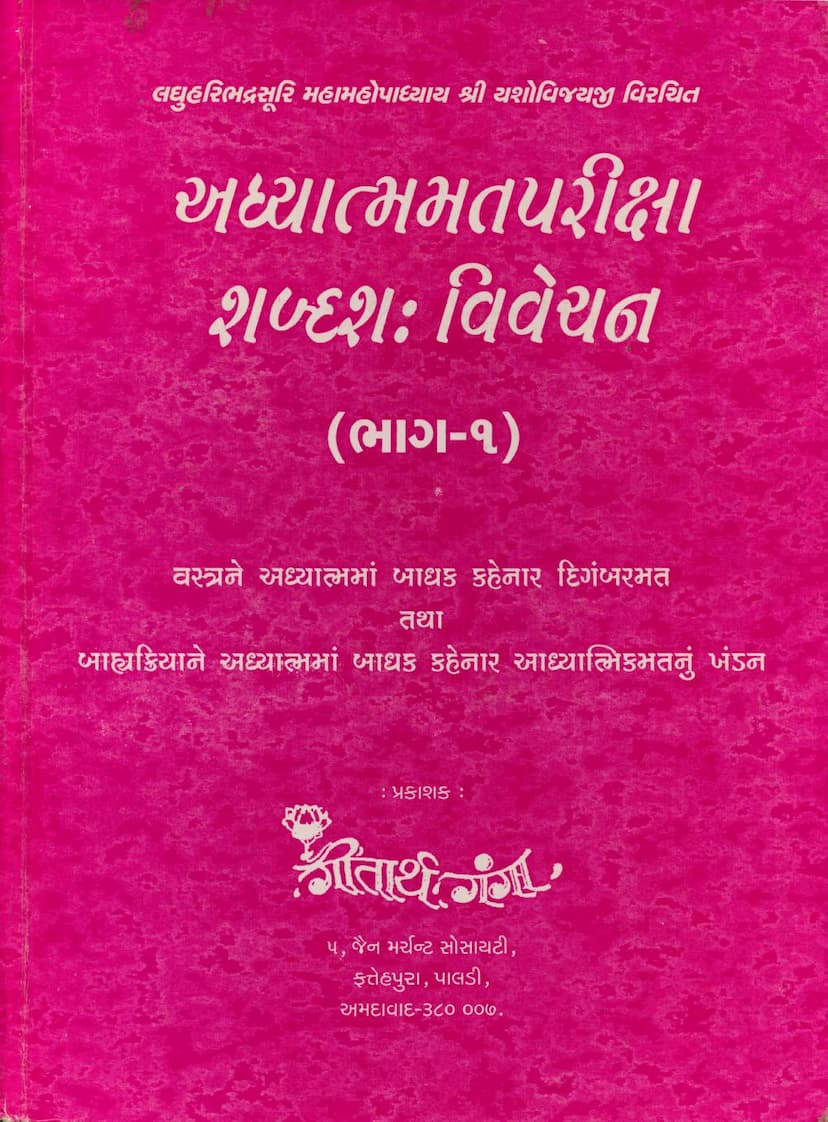Adhyatmamatpariksha Shabdasha Vivechan Part 01
Added to library: September 1, 2025

Summary
This Jain text, "Adhyatmamatpariksha Shabdasha Vivechan Part 01," authored by Pravinchandra K Mota and published by Gitarth Ganga, is the first part of a detailed commentary (Shabdasha Vivechan) on the original work "Adhyatmamatpariksha" by Acharya Yashovijayji. The book aims to examine and clarify the true nature of "Adhyatma" (spirituality) as understood in Jain philosophy.
Here's a comprehensive summary of the content, based on the provided pages:
Core Objective of the Text:
The primary goal of the book is to scrutinize the views of those who identify themselves as "Adhyatmik" (spiritualists) but, according to Jain teachings, are merely "Naam Adhyatmik" (spiritualists in name only). The author, Pravinchandra K Mota, elaborates on the extensive and profound analysis of various philosophical concepts within Jain Shastras, as composed by earlier scholars like Acharya Haribhadrasuri and Upadhyay Yashovijayji. The text aims to provide a comprehensive understanding of the principles of Naya (standpoint), Nikshepa (classification), Vyavahar (conventional truth), and Nishchay (ultimate truth) in relation to Adhyatma.
Key Themes and Arguments (Covered in Part 01, Gatha 1-71):
The book's structure and content, as outlined, aim to address several critical points, primarily focusing on refuting the misconceptions held by Digambara Jains and certain interpretations of "Adhyatmik" views, particularly concerning attachment to possessions (Upadhi) and outward practices.
-
Defining True Adhyatma: The text begins by establishing the true definition of Adhyatma. It clarifies that Adhyatma is not merely internal contemplation of the pure soul but involves righteous actions undertaken by a qualified individual in relation to the Three Jewels (Samyak Darshan, Samyak Gyan, Samyak Charitra). It details the process of conquering passions (Kashays) through these appropriate actions.
-
Refuting Digambara Views on Upadhi (Possessions):
- Clothing and Utensils: A significant portion of the text is dedicated to refuting the Digambara stance that clothing (vastra) and other possessions (patra) are inherently obstacles to Adhyatma and are to be considered as absolute possessions (Parigraha). The author argues, through logical reasoning and scriptural evidence, that possessions accepted according to Shastric injunctions are not opposed to Adhyatma and can even be conducive to its growth.
- Nudity vs. Wearing Clothes: The text addresses the Digambara belief in nudity (Nagnta) as a prerequisite for spiritual practice, contrasting it with the Shvetambara acceptance of appropriate clothing. It argues that prescribed adherence to Shastric rules regarding clothing allows for spiritual progress.
- The Concept of Utsarga and Apavada: The book delves into the Digambara understanding of Utsarga (general rule) and Apavada (exception). It clarifies how clothing and other possessions are not contrary to Adhyatma when accepted with the right intention and in accordance with Shastric guidelines.
-
Addressing the Nature of Attachment and Vows:
- External vs. Internal Purity: The text critiques the "Naam Adhyatmik" followers who believe that only internal states of being (like pure soul contemplation) constitute Adhyatma, dismissing external practices like purification rituals (Padilehan) and other ascetic disciplines as mere physical actions (Kayachesta) that cannot lead to spiritual progress. The author argues that external practices, when performed with the right understanding and intention, are not generated by or do not generate attachment (Raga).
- Pudgala and Adhyatma: It explains that actions related to matter (Pudgala) are not inherently opposed to Adhyatma. The key is the intention and detachment with which these actions are performed.
- The Role of Yoga: The text elaborates on the concept of Yoga and how actions are achieved through it. It emphasizes that the desire for results from actions is rooted in attachment and aversion (Raga-Dvesha), which are to be conquered.
-
The Role of Naya (Standpoints): The text extensively uses and explains the principles of Naya (like Nishchaya and Vyavahara) to reconcile seemingly contradictory scriptural statements and to demonstrate how different viewpoints are essential for a complete understanding of reality. It refutes the absolute acceptance of any single viewpoint, highlighting the importance of Anekantavada (non-absolutism).
-
Analyzing Raga and Dvesha (Attachment and Aversion): The text provides a detailed analysis of Raga and Dvesha, showing how they can be both praiseworthy (Prashasta) and unpraiseworthy (Aprashasta) depending on the context and intention, thereby refuting the Digambara view that Dvesha is always unpraiseworthy.
-
The Interplay of Daiva (Destiny) and Purushkar (Effort): The text explores the concept of destiny and effort, illustrating how both play a role in both worldly and spiritual attainments. It discusses the relative strength of each in different circumstances.
-
The Nature of Adhyatma and the Path to Moksha: The book emphasizes that true Adhyatma is attained through the practice of Right Faith, Right Knowledge, and Right Conduct, leading to the victory over passions and senses. It highlights that mere intellectual understanding of the soul's nature, without corresponding action and effort, is insufficient for liberation.
-
Critique of "Naam Adhyatmiks": The text identifies individuals who claim spiritual attainment based on mere intellectual understanding of the soul's nature, while neglecting essential practices and external disciplines prescribed by the Shastras. These are characterized as "Naam Adhyatmik" (spiritualists in name only) who are detached from the practical aspects of the path.
Overall Structure and Approach:
- Critique and Refutation: The book systematically presents the views of the "Adhyatmik" and Digambara perspectives and then rigorously refutes them with logical arguments, scriptural evidence, and dialectical reasoning.
- Emphasis on Anekantavada: The author skillfully employs the Jain principle of Anekantavada, presenting different standpoints (Naya) and then reconciling them to reveal the ultimate truth.
- Comprehensive Analysis: The commentary aims to offer a deep dive into the nuances of Jain philosophy, covering intricate details of the path to liberation.
In essence, "Adhyatmamatpariksha Shabdasha Vivechan Part 01" serves as a profound exploration and defense of Jain spiritual principles, aiming to correct misinterpretations and guide sincere seekers toward the true path of Adhyatma and Moksha, emphasizing the indispensable role of both knowledge and conduct.